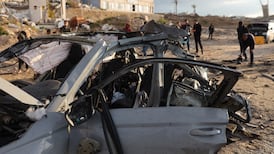Israel is preparing to push troops and armour deeper into the Gaza Strip, in a move that would uproot tens of thousands more Palestinians, intensify international criticism and increase the risks to its own soldiers’ lives.
The Israeli military is racing to destroy a network of Hamas tunnels more extensive than it previously thought, say analysts.
Condemnation of the war outside Israel is growing and diplomatic efforts to end it are gathering pace, with Egypt expected to play a leading role.
On Monday night, the Israel Defence Forces (IDF) dropped leaflets and sent phone messages ordering residents of Jabalya and Beit Lahiya, in northern Gaza, and al-Sheja’iya, in the east, to move.
Similar warnings earlier this month in areas bordering Israel were followed by bombardment that killed hundreds of Palestinians.
With the Gaza death toll now above 1,100 – mostly civilians – bringing international censure of Israeli prime minister Binyamin Netanyahu’s government, it is facing questions in Israel as to why it did not destroy the tunnels sooner.
In the buffer zone around the Israeli-Gaza border, armoured vehicles and earthmovers are throwing up thick clouds of dust as they search for concealed openings to tunnels that the IDF says average 3km in length, branch off into side passages and open in houses, mosques or other buildings on the Gaza side.
“We will not complete the mission, we will not complete the operation, without neutralising the tunnels, the sole purpose of which is the destruction of our civilians and the killing of our children,” Mr Netanyahu said on Monday, shortly before Israel began some of the heaviest bombardment of targets in Gaza since the beginning of the operation.
Monday was the bloodiest day of the war yet for Israel, as 10 soldiers were killed, taking the number of Israeli military dead to 53.
A few hours before Mr Netanyahu spoke, a group of four to eight Palestinian militants emerged from a tunnel near an Israeli army building at Nahal Oz, on the Gaza border, and shot and killed four soldiers, the IDF said. The Palestinian fighters escaped back into the tunnel but Israel’s military said it shot one.
Yesterday Operation Protective Edge entered its 22nd day, making it longer than Operation Cast Lead, Israel’s first war against Hamas in 2008-2009.
Mr Netanyahu launched the operation on July 7th after weeks of growing cross-border friction, with the aim of stopping Hamas from firing rockets and weakening the group.
Threat receding
The threat now seems to be receding: a senior Israeli intelligence officer said on Sunday that bombing of launch sites and other targets had reduced Hamas’s estimated prewar arsenal of more than 9,000 rockets by at least 50 per cent.
On July 17th, Mr Netanyahu expanded the war to ground operations as Israel’s military pushed into the buffer zone and border areas of Gaza, carving out a perimeter of about 2km, where it has bombed heavily, forcing about 10 per cent of Gaza’s 1.8 million population to leave their homes.
The IDF says it has discovered more than 40 tunnels, which it says are built from thousands of prefabricated concrete sections with the power supplies and conveyor belts to shift earth. It says each one cost Hamas $1 million (€746,000) to $2 million to build, and there are another 20 to 30 it has not yet found.
Without reliable technology to detect tunnels, Israel is relying on intelligence to find their entrances, which are concealed on the Israeli side.
“When you dig down to find the tunnels, if you haven’t found an access point, it’s a needle in a haystack,” said Lieut Col Peter Lerner, an IDF spokesman.
Analysts say the tunnels have given Hamas a tactical edge against one of the world’s strongest armies.
“They are trying to avoid a total confrontation by using the tunnel system,” said Maj Gen Israel Ziv, a former head of the IDF Gaza division.
Israeli forces will be pushing deeper into crowded urban neighbourhoods, he said. Because of the tunnels, many of which are booby trapped, Israeli soldiers are dealing with “a kind of 360-degrees front”.
As it moved into border areas, the IDF levelled entire city blocks in Beit Hanoun and al-Sheja’iya, rendering swathes of the border area uninhabitable.
Military analysts said Israel’s enhanced bombing campaign this week likely reflected Mr Netanyahu’s determination to neutralise the tunnels before stuttering diplomatic manoeuvres bring an end to the war.
“I think that he is groping for time,” said Oded Eran, senior research fellow at the Institute for National Security Studies in Tel Aviv.
“You have several targets – some you knew before; others you find through intelligence or operations – then you’re in a race until the international community says firmly: Stop.”
Questions over motives
Doubts about Israel’s rationale for declaring war on Hamas and invading Gaza have resurfaced amid an argument over who ordered the kidnapping and killing of three Jewish teenagers in the West Bank city of Hebron last month – the act that set the conflict in motion
After the boys’ disappearance, Mr Netanyahu blamed “Hamas terrorists”, arresting hundreds of the Islamist group’s members and igniting a conflict in which about 1,100 Palestinians and 55 Israelis have been killed.
“Hamas is committed to the destruction of Israel and to carrying out terrorist attacks against Israeli civilians, including children,” he said on June 15th.
Palestinian officials said the crackdown was aimed at sabotaging their nascent reconciliation. Some Israeli media also criticised the handling of the police investigation and questioned Mr Netanyahu’s allegations. – (Copyright The Financial Times Limited 2014)











